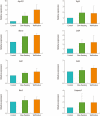In vitro development and gene expression of frozen-thawed 8-cell stage mouse embryos following slow freezing or vitrification
- PMID: 22384443
- PMCID: PMC3283077
- DOI: 10.5653/cerm.2011.38.4.203
In vitro development and gene expression of frozen-thawed 8-cell stage mouse embryos following slow freezing or vitrification
Abstract
Objective: This study was performed to compare the efficiency of slow freezing and vitrification based on survival, development to blastocysts, and cell numbers of blastocysts. Changes in embryonic gene expression in fresh and frozen-thawed embryos were also examined.
Methods: Eight-cell stage embryos were collected from superovulated female BDF1 mice. The collected embryos were randomly divided into three groups. One group was maintained as fresh controls (n=42), one was frozen by slow freezing (n=43), and one was cooled by vitrification (n=43). After thawing or cooling, survival rates, development to blastocyst, and cell numbers and inner cell mass (ICM) cell numbers of blastocysts were compared with those of the control group. The expressions of eight genes (Rbm3, Birc5, Sod1, Sod2, Cirbp, Caspase3, Trp53, Hsp70.1) were examined by real time-quantitative polymerase chain reaction in the fresh and frozen-thawed embryos.
Results: There were no significant differences in the slow freezing and vitrification groups' survival rate after thawing (88.4% vs. 88.4%), development to blastocyst (100% vs. 97.4%), cell numbers (107.0±21.0 vs. 115.0±19.7), or ICM cell numbers of blastocysts (11.3±5.2 vs. 11.1±3.7). Cell numbers of blastocysts were significantly (p<0.05) lower in the frozen-thawed embryos than the fresh embryos. There were no significant differences in the slow freezing and the vitrification groups' expressions of the eight genes. The expressions of CirbP and Hsp70.1 were higher in the frozen-thawed embryos than in the fresh embryos but there were no significant differences.
Conclusion: These results suggest that there were no significant differences between embryos that underwent slow freezing and vitrification.
Keywords: Cryopreservation; Gene expression; Human; RT-qPCR; Slow freezing; Vitrification.
Conflict of interest statement
No potential conflict of interest relevant to this article was reported.
Figures
Similar articles
-
Mitochondrial bioenergetic profiles of warmed bovine blastocysts are typically altered after cryopreservation by slow freezing and vitrification.Theriogenology. 2024 Jan 15;214:21-32. doi: 10.1016/j.theriogenology.2023.10.002. Epub 2023 Oct 10. Theriogenology. 2024. PMID: 37839094 Review.
-
Perinatal and maternal outcome after vitrification of blastocysts: a Nordic study in singletons from the CoNARTaS group.Hum Reprod. 2019 Nov 1;34(11):2282-2289. doi: 10.1093/humrep/dez212. Hum Reprod. 2019. PMID: 31687765
-
Clinical outcomes following cryopreservation of blastocysts by vitrification or slow freezing: a population-based cohort study.Hum Reprod. 2014 Dec;29(12):2794-801. doi: 10.1093/humrep/deu246. Epub 2014 Oct 14. Hum Reprod. 2014. PMID: 25316444
-
Vitrification yields higher cryo-survival rate than slow freezing in biopsied bovine in vitro produced blastocysts.Theriogenology. 2021 Sep 1;171:44-54. doi: 10.1016/j.theriogenology.2021.04.020. Epub 2021 May 13. Theriogenology. 2021. PMID: 34023618
-
Vitrification improves in-vitro embryonic survival in Bos taurus embryos without increasing pregnancy rate post embryo transfer when compared to slow-freezing: A systematic meta-analysis.Cryobiology. 2021 Aug;101:1-11. doi: 10.1016/j.cryobiol.2021.06.007. Epub 2021 Jun 26. Cryobiology. 2021. PMID: 34186088 Review.
Cited by
-
Alternation of apoptotic and implanting genes expression of mouse embryos after re-vitrification.Int J Reprod Biomed. 2016 Aug;14(8):511-8. Int J Reprod Biomed. 2016. PMID: 27679826 Free PMC article.
-
Astaxanthin Added during Post-Warm Recovery Mitigated Oxidative Stress in Bovine Vitrified Oocytes and Improved Quality of Resulting Blastocysts.Antioxidants (Basel). 2024 Apr 30;13(5):556. doi: 10.3390/antiox13050556. Antioxidants (Basel). 2024. PMID: 38790660 Free PMC article.
-
Cold-inducible proteins CIRP and RBM3, a unique couple with activities far beyond the cold.Cell Mol Life Sci. 2016 Oct;73(20):3839-59. doi: 10.1007/s00018-016-2253-7. Epub 2016 May 4. Cell Mol Life Sci. 2016. PMID: 27147467 Free PMC article. Review.
-
Time-lapse monitoring reveals that vitrification increases the frequency of contraction during the pre-hatching stage in mouse embryos.J Reprod Dev. 2016 Apr 22;62(2):187-93. doi: 10.1262/jrd.2015-150. Epub 2016 Jan 25. J Reprod Dev. 2016. PMID: 26806421 Free PMC article.
-
Mild hypothermia promotes the viability of in vitro-produced bovine blastocysts and their transcriptional expression of the cold-inducible transcription factor Rbm3 during in vitro culture.J Reprod Dev. 2019 Jun 14;65(3):275-280. doi: 10.1262/jrd.2018-142. Epub 2019 Mar 23. J Reprod Dev. 2019. PMID: 30905884 Free PMC article.
References
-
- Steptoe PC, Edwards RG. Birth after the reimplantation of a human embryo. Lancet. 1978;2:366. - PubMed
-
- Liebermann J, Dietl J, Vanderzwalmen P, Tucker MJ. Recent developments in human oocyte, embryo and blastocyst vitrification: where are we now? Reprod Biomed Online. 2003;7:623–633. - PubMed
-
- Trounson A, Mohr L. Human pregnancy following cryopreservation, thawing and transfer of an eight-cell embryo. Nature. 1983;305:707–709. - PubMed
-
- Cohen J, DeVane GW, Elsner CW, Fehilly CB, Kort HI, Massey JB, et al. Cryopreservation of zygotes and early cleaved human embryos. Fertil Steril. 1988;49:283–289. - PubMed
-
- Rama Raju GA, Haranath GB, Krishna KM, Prakash GJ, Madan K. Vitrification of human 8-cell embryos, a modified protocol for better pregnancy rates. Reprod Biomed Online. 2005;11:434–437. - PubMed
LinkOut - more resources
Full Text Sources
Research Materials
Miscellaneous


